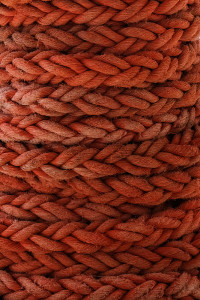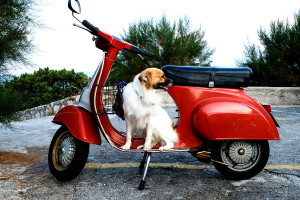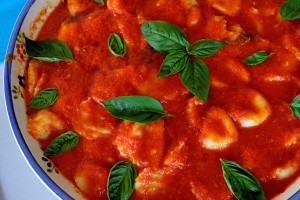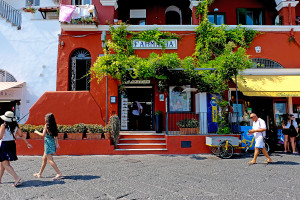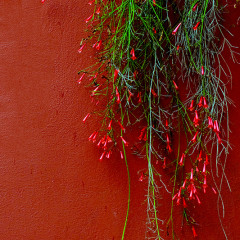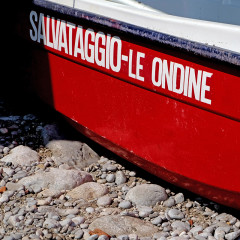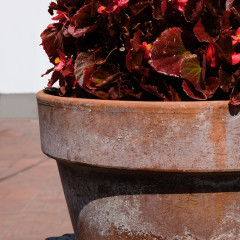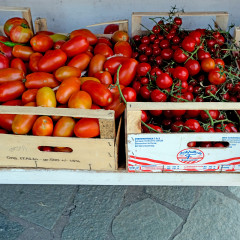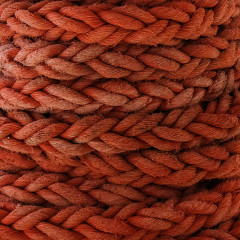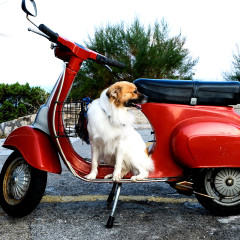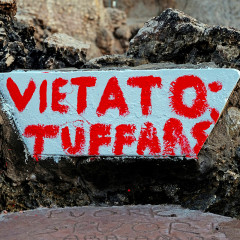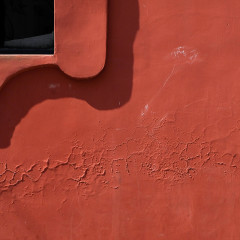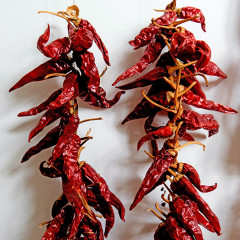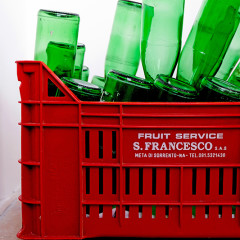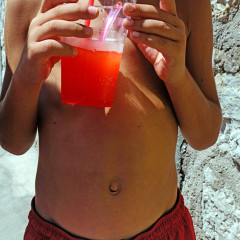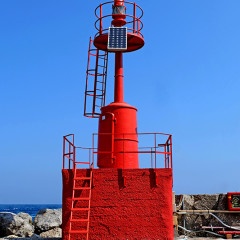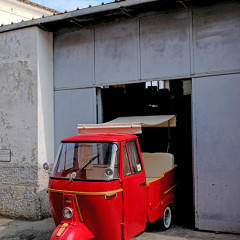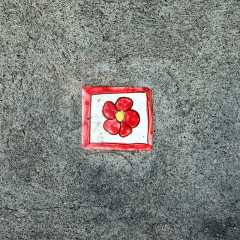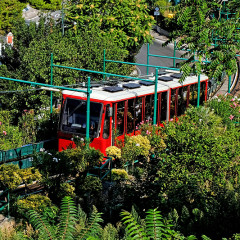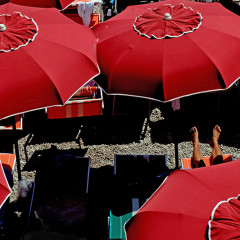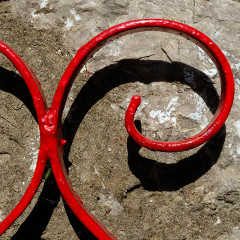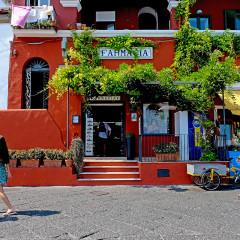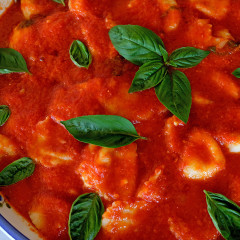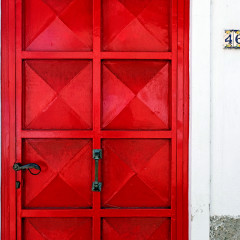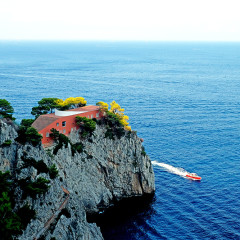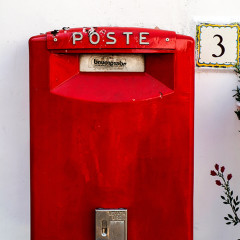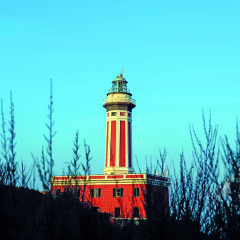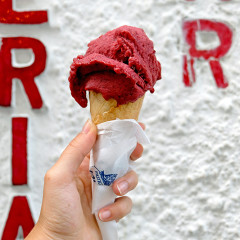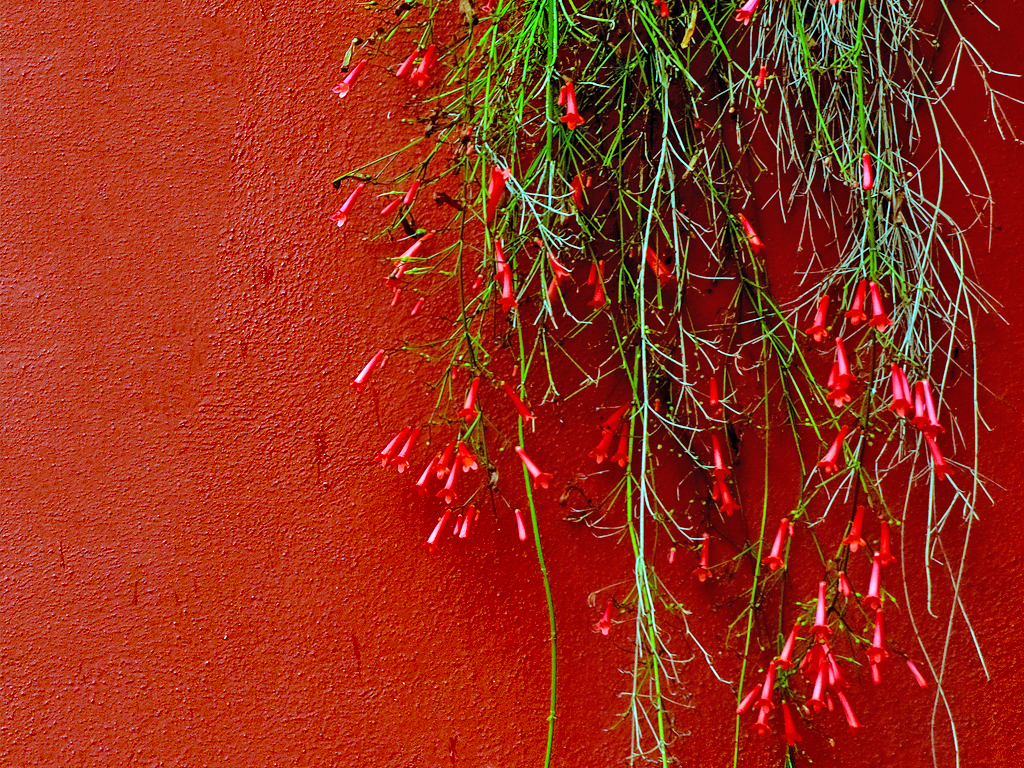
Non solo azzurra
Scarlatto, borgogna, carminio, granata, magenta, cremisi. Un fil rouge ci guida in un percorso costellato dalle infinite sfumature del colore del fuoco
testo e foto di Simona Schettino
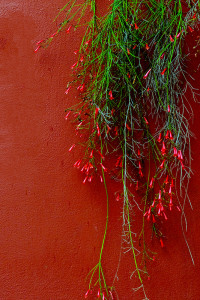 Ci sono cose che non richiedono molte parole per essere descritte. Come, per esempio, quella a cui serve solo un filo d’olio, sale, origano, due foglie di basilico preferibilmente appena raccolte, ed ecco quello che a Capri è il concentrato più rosso che nel resto del mondo, la “pummarola”.
Ci sono cose che non richiedono molte parole per essere descritte. Come, per esempio, quella a cui serve solo un filo d’olio, sale, origano, due foglie di basilico preferibilmente appena raccolte, ed ecco quello che a Capri è il concentrato più rosso che nel resto del mondo, la “pummarola”.
È con questo profumo nelle narici che inizia un piccolo viaggio dal colore del fuoco tra le viuzze e i muri screpolati dell’isola azzurra che questa volta si spoglia del blu per indossare le sfumature delle 19:35 di un giorno di luglio, quel momento in cui il sole scende gli ultimi gradini della Scala fenicia, si poggia su Ischia e la Piazzetta s’infiamma.
Il rosso è un colore capriccioso in tutti i sensi. Ci sono giorni che fa innamorare e giorni che parla di dolore. Giorni che fa battere il cuore e giorni che è soltanto sangue e niente più. Un lungo e antico susseguirsi di amore e odio, passione e ferita, un continuo contrasto il cui unico fil rouge, per l’appunto, è la forte intensità. Il rosso non è mai amore e basta, è sempre troppo amore, non è mai solo fiamme ma sempre troppo fuoco; il rosso è sempre troppo rosso come Capri è sempre troppo bella, troppo magica, troppo Capri.
Il primo rosso dell’isola si scorge arrivando, ma quasi nessuno lo vede. Immobile e goffo, dalle linee arrotondate, resta fermo sull’orlo del porto in cerca di attenzioni. Lui è un faro, ma non quello famoso di Punta Carena, rosso castagno, imperioso e vanitoso, è piuttosto rosso scarlatto, brillante e luminoso ma a quanto pare non abbastanza perché lo sguardo, una volta sbarcati, viene catturato da un rosso diverso. Sesto blocchetto di case partendo da destra, quattro piani e quattro archetti, sembra farsi spazio incastrato tra balconi e muri portanti. Il suo rosso borgogna si sfuma in quelle che sono una farmacia, una salumeria e una pescheria.
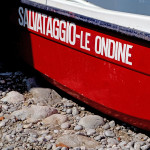 Il via vai continuo di turisti curiosi gli si annoda davanti in forma di mare agitato mentre attendono la prossima corsa del rosso più futurista di Capri, la funicolare. Un sali-scendi breve e panoramico dipinto da Depero e frequentato dalle più disparate personalità storiche e contemporanee, nazionali e internazionali. Un rosso che anche questa volta non rinuncia al suo essere arbitrario e che, sotto forma di scatola con porte scorrevoli, fa quello che Totò ci ha tramandato come ‘a Livella. Nella funicolare si possono incontrare il divo di Hollywood e il fornaio, il bambino che va al mare, i pendolari, i bassotti e la signora che scende “basc a’ marin”. La funicolare è la versione caprese e materiale di un immaginario Purgatorio dantesco dove, una volta arrivati in cima, non c’è il Paradiso e il rosso cielo di Marte ma la Piazzetta e il rosso mattone dell’ampio pavimento che accoglie, l’insegna rosso porpora del bar Caso, la buganvillea carminio che si arrampica lungo il muro del palazzo del Comune, l’intonaco rosso ruggine della costruzione dirimpetto al campanile il cui balcone è il posto perfetto per ammirare la vita, anzi le vite di quelle persone che non sono in Paradiso ma immaginano di esserci.
Il via vai continuo di turisti curiosi gli si annoda davanti in forma di mare agitato mentre attendono la prossima corsa del rosso più futurista di Capri, la funicolare. Un sali-scendi breve e panoramico dipinto da Depero e frequentato dalle più disparate personalità storiche e contemporanee, nazionali e internazionali. Un rosso che anche questa volta non rinuncia al suo essere arbitrario e che, sotto forma di scatola con porte scorrevoli, fa quello che Totò ci ha tramandato come ‘a Livella. Nella funicolare si possono incontrare il divo di Hollywood e il fornaio, il bambino che va al mare, i pendolari, i bassotti e la signora che scende “basc a’ marin”. La funicolare è la versione caprese e materiale di un immaginario Purgatorio dantesco dove, una volta arrivati in cima, non c’è il Paradiso e il rosso cielo di Marte ma la Piazzetta e il rosso mattone dell’ampio pavimento che accoglie, l’insegna rosso porpora del bar Caso, la buganvillea carminio che si arrampica lungo il muro del palazzo del Comune, l’intonaco rosso ruggine della costruzione dirimpetto al campanile il cui balcone è il posto perfetto per ammirare la vita, anzi le vite di quelle persone che non sono in Paradiso ma immaginano di esserci.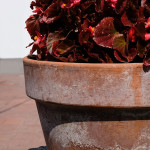
Le strade di Capri sono lunghe e strette. Si disperdono come la foce a delta di un fiume sul dorso dell’isola e spesso nascondono piccole soprese tra una curva e l’altra: pareti rosse ad esempio. Non di rado, capita d’imbattersi nel bel mezzo di un segmento di strada rosso sangria, o meglio ancora rosso falun, per dirla alla svedese. Percorrendo tipiche stradine come via Padre Reginaldo Giuliani, via Sella Orta, via Tragara, oppure nell’incrocio esatto tra via Longano e via Sopramonte, ecco sbucare pochi metri d’ingiustificato rosso in contrasto con gli occhi pieni di bianco e di blu di cui l’isola abbonda. Sembra che il capriccioso colore in questione, ancora una volta, voglia ricordare la sua presenza e che anche se gli è stato assegnato il colore dell’amore, quello del Natale e del battito della vita, lascerà comunque il segno in tutte le questioni che non lo riguardano, come le strade per l’appunto, ma che, in effetti, a Capri si percorrono spesso con il cuore che batte forte.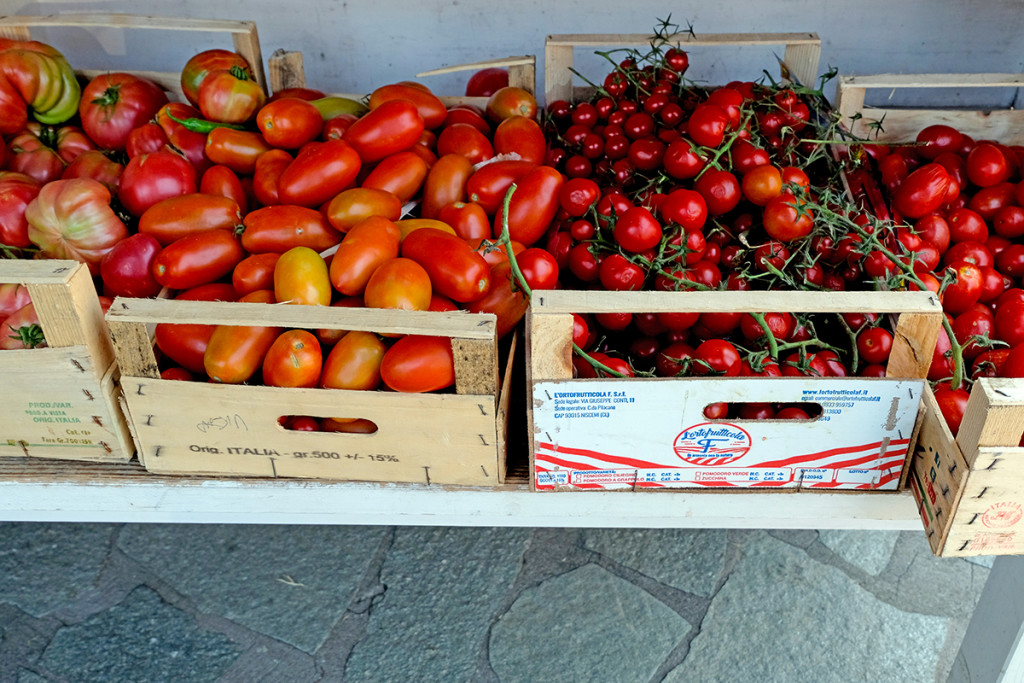
Poi c’è l’architettura, l’arte dell’abitare, quella che sull’isola è tipicamente costituita da archi e colonne candidi e sospesi, macchie di pace nel mezzo della flora mediterranea. Un’architettura che non disturba i pini e neanche i campi di mirto e lentisco, è timida e rispettosa. Ma i capricci del rosso si sono stesi anche su certe case, come un’inaspettata cascata di pittura. La Casa Rossa, Casa Malaparte e Villa Pompeiana sono rosse, rosse come l’eccentricità dei loro ideatori e delle storie che le avvolgono e rosse come il punto e virgola nel mezzo di una frase, indispensabile e inaspettato. La rossa personalità di queste case ha superato la rottura della tradizione per diventare un punto di riferimento, un segnale ma anche una boccata d’ossigeno che ricorda che la diversità esiste ed è bellissima.
Ma il rosso a Capri non è fatto solo di fondamenta e pareti scarlatte, molto spesso ha anche quattro, tre o due ruote e sfreccia nelle curve frizzanti di Anacapri. Sono i tricicli, i carrelli e le vespe rosso melograno che gironzolano sull’isola come coriandoli, amati dai capresi per la loro comodità e per quel ricordo antico che racchiudono nelle loro forme. Perché a Capri c’è una diffusa allergia ai cambiamenti e il rosso di quella vernice sigilla in qualche modo un po’ di passato come le conserve nella dispensa che ci rasserenano.
La serenità della certezza, come quella che ci regala il sole ogni giorno quando da Punta Carena ci dà la conferma che la giornata è finita e per qualche ragione che potrebbe essere scientifica, decide di rasserenarci con il rosso di Persia, il granata, il vermiglione, il magenta e il cremisi. Diventano rossi il mare, gli scogli, le guance e, se siamo fortunati, diventerà rossa anche quella luna tanto cantata che “mme parla ‘e te”.
Not Only Blue
Scarlet, burgundy, carmine, garnet, magenta, crimson. A red thread guiding us along a path aflame with countless shades of the colour of fire
text and photos by Simona Schettino
There are some things that don’t need a lot of words to describe them. For example, the pummarola, which is the Capri tomato sauce that is the reddest in the world, made by adding a little olive oil, salt, oregano and a couple of basil leaves, preferably freshly picked.
This is the aroma that begins our flame-coloured journey through the narrow streets lined with cracked walls on this blue Island when, at 7.35 pm on a July day, the sun going down the last steps of the Scala Fenicia, shines on Ischia and the Piazzettta seems to catch fire.
Red< is a capricious colour in every sense of the word. There are days when it makes you fall in love and days when it expresses pain. Days when it makes your heart beat fast and days when it is only blood and nothing else.
A long timeless sequence of love and hate, passion and suffering, a constant contrast in which the only red thread is its great intensity. Red is never just love and that’s all, it’s always too much love, it’s never just flames but always too much fire; red is always too red, just as Capri is always too beautiful, too magical, too Capri.
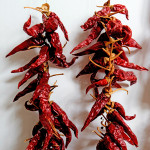
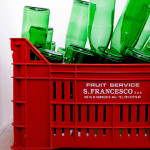
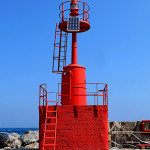
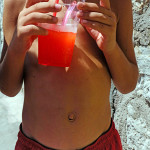 You glimpse the first red on the island as you are about to land, but hardly anyone notices it. Motionless and clumsy, its rounded shape stands at the edge of the harbour seeking attention. It is a lighthouse, but not that famous one at Punta Carena, chestnut red, imperious and vain. This one is bright scarlet, but apparently not bright enough, because as soon as you have disembarked your gaze is captured by a different red. The sixth little block of buildings starting from the right, four floors and four arches, seems to have pushed itself into the space between balconies and bearing walls. Its burgundy red takes on different shades in the pharmacy, charcuterie and fish shop.
You glimpse the first red on the island as you are about to land, but hardly anyone notices it. Motionless and clumsy, its rounded shape stands at the edge of the harbour seeking attention. It is a lighthouse, but not that famous one at Punta Carena, chestnut red, imperious and vain. This one is bright scarlet, but apparently not bright enough, because as soon as you have disembarked your gaze is captured by a different red. The sixth little block of buildings starting from the right, four floors and four arches, seems to have pushed itself into the space between balconies and bearing walls. Its burgundy red takes on different shades in the pharmacy, charcuterie and fish shop.
The constant wave of curious tourists pass them like a choppy sea as they wait for the next cable car on the funicular, painted the most futurist red on Capri. A short panoramic ride depicted by Fortunato Depero and taken by a melting pot of personalities, both past and present, national and international. A red which this time too is quite arbitrary and, in the form of a red box with sliding doors, acts as a leveller, recalling Totò’s poem ‘a Livella (The Spirit Level). In the cable car you find the Hollywood star, the baker, the little boy going to the sea, commuters, dachshunds and the lady going down to the beach. The funicular is the real Capri version of an imaginary Dantesque Purgatory. However, when you get to the top, there’s no Paradise and red sky of Mars, but the Piazzetta and the brick red of the paving in the square. Then the purplish red of the Bar Caso sign, the carmine bougainvillea climbing over the Town Hall and the rust red of the building opposite the bell tower, whose balcony is the perfect spot for watching the life of the people who are not in Paradise, but imagine they are.
The roads on Capri are long and narrow. They spread out like a river delta along the ridge of the island and often you find little surprises in store around the next bend. For example red walls.
It is not unusual to come across a stretch of sangria red, or rather falun red as they call it in Sweden. Walking along typical narrow roads like Via Padre Reginaldo Giuliani, Via Sella Orta, Via Tragara, or at the intersection between Via Longano and Via Sopramonte, you suddenly glimpse a few metres of unexpected red in contrast to the blue and white that dominate on the island. It seems that this capricious colour wants to make its presence felt, yet again. And though it is known as the colour of love, Christmas and the throb of life, it still leaves its mark on things that have nothing to do with it. Roads for instance, but actually as you walk along them on Capri they often make your heart beat fast.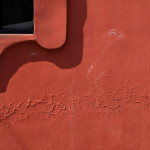
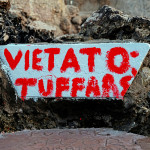
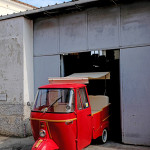
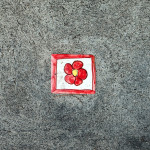
Then there’s the architecture, the art of living, which on the island typically consists of white arches and columns, havens of peace suspended amidst the Mediterranean flora. An architecture that does not disturb the pines, or the areas of myrtle and mastic trees, but is shy and respectful. However, whimsical washes of red are even to be found on certain houses, like unexpected cascades of paint. The Casa Rossa, Casa Malaparte and Villa Pompeiana are red, red like the eccentricity of their owners and the stories that have grown up around them, and red like the semi-colon in the middle of a sentence, indispensable and unexpected. The red personality of these houses is stronger than their break with tradition and they have become a reference point, a signal, but also a breath of fresh air, reminding us that diversity exists and is beautiful.
But the red on Capri does not only consist of scarlet walls, very often it has four, three or two wheels and speeds round the exciting bends of Anacapri. These belong to the pomegranate red tricycles, carts and scooters that ride round the island like streamers. The Capresi love them because they’re so convenient and they remind them of old times. Also because there’s a widespread allergy to change on Capri and the red of that paint seems to seal up a bit of the past, and is as reassuring as the preserves in the larder.
A sense of serenity and certainty, like that which the sun gives us daily, when from Punta Carena it tells us that the day is over and, for some reason that may be scientific, reassures us with its Persian red, garnet, vermilion, magenta and crimson. The sea, the rocks, your cheeks and, if you’re lucky, even the moon from that popular song Luna Rossa (Red Moon) that “me parla ‘e te” (“tells me about you”) all turn red.


